|
|
Cinque
Terre,
Italy
October
2-8, 2005 |
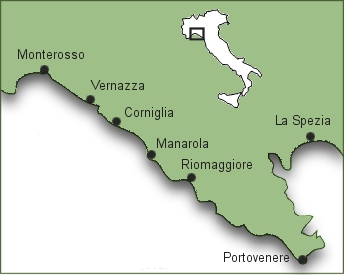
|
|
|
|
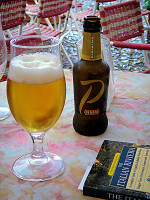
Tools of the trade.
|
D had been
working in the Savoie region of France for three months,
and it was time for a break. He had been struggling
with the decision of whether to go to Corsica or Liguria.
A hike along part of the Italian Riviera and visiting
the Cinque Terre villages sounded more appealing and
finally won out. D collected J from the Lyon airport
and were on the train to Italy the next morning. Shortly
before the border crossing at Modane, D realized he
had left his passport back at his apartment. Given
that the Olympics were to take place in Turin within
4 months, this oversight was certainly going to spell
trouble. As the garda inched through the train
checking documentation, D started to break a sweat.
When it was his turn, he rummaged through his backpack
and feigned surprise at not finding his passport.
D was made to wait in the diner car with a Muslim
guy while the garda swept the remainder of
the train. D explained the situation and produced
his Massachusetts driver’s license as his only form
of identification. The officer looked on suspiciously
as he took it all in. J was brought in to the act,
and after some deliberation on beginning a new life
with some fine Italian man, she corroborated D's story
to ensure his freedom.
|
|
|

Our first glimpse of the tower.
|
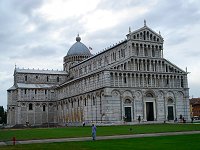
The Pisa Duomo.
|

One of the best angles to see the
lean.
|
|
|
Since it’s
only about 45 min south of the Cinque Terre, we decided
to officially begin our journey in Pisa. J had never
been, and D had not been there in 20 years, and even
then it was just long enough to dash across town and
see the tower during a 2am train layover. We had spent
the whole day in transit coming from France, thus
Priority #1 upon arrival was to find a place to crash.
Unfortunately it was raining buckets, so we were limited
to finding something near the central train station,
which we did for 89 euros a night. After freshening
up, the rain subsided to a drizzle, and we scampered
across the river to see the tower at night. It is
a spectacular sight when illuminated. It is also free
and accessible. To be permitted to walk right up to
the base of Pisa’s primary moneymaker at night in
this day and age is amazing.
The famed tower
is actually the bell tower which corresponds to the
adjoining Pisa Duomo (Cathedral of Pisa). The Piazza
di Maracoli (Square of Miracles) is also known as
Campo di Miracoli (Field of Miracles) because it was
a one time estuary which explains the soft ground
on which it was built. Other buildings in the complex
include the domed Battistero (baptistery) and the
massive Camposanto (cemetery). The area is partially
surrounded by the old city walls. However, it is very
difficult to not spend your whole visit gazing at
and photographing the tower. Construction of La Torre
di Pisa was begun in 1173 and finally finished 200
years later. The eight-story tower is believed to
have begun leaning after the completion of the third
story. A 100 year pause in construction ensued allowing
the soil to settle and most likely enabling further
construction of the tower. Still the tower continued
to lean to the south at an increasing rate which was
exacerbated by the installation of the tower’s seven
bells. Over the centuries, there has been an international
effort to prevent the tower from falling including
cementing the foundation, using weights, and attaching
cables. Only recently has the tower been stabilized
for the long-term when a team exercised the brilliantly
simple idea of removing soil from the north side of
the tower. Galileo, who attended the nearby University
of Pisa in the 1580s, reputedly used the tower to
stage his experiment to disprove the Aristotelian
theory that objects fall at the same rate.
Just outside
the Piazza di Miracoli is a hotel with stunning views
of the tower from its rooms. On a whim, D inquired
about their rates – 70 euros a night. Already, our
trip was off to a great start. We strolled back to
our overpriced shoebox but ducked into a nearby café
for some sustenance – a wood-fired pizza and some
out-of-this-world focaccia with prosciutto and mozzarella.
This would literally be a taste of things to come.
|
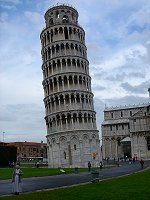
Using a nun for scale.
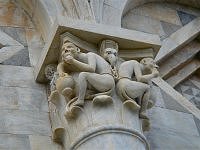
One of several sculptured capitals
decorating the tower.

Under the lean.
|
|

Old Roman baths near the Tower.
|
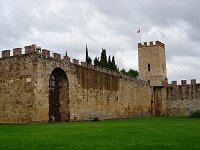
The wall protecting the Campo
di Maracoli.
|
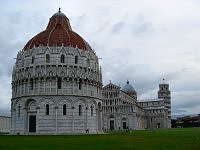
The impressive Battistero in the foreground.
|
|
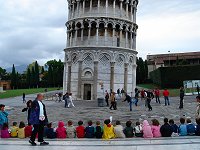
School kids sketching on a fieldtrip.
|
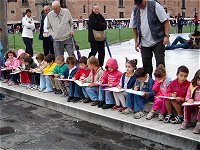
There was much discussion and some
blatant copying going on.
|

Michelangelo in the making.
|
|
|
|
Just before La Spezia, considered
the gateway to the Cingue Terre and north of the famed
Carrara marble quarries, lays the town of Sarzana.
We had made good time and our guide book showed the
town had both a castle and a fortress, so we decided
to jump off of the train and have a look around. Sarzana
sprouted up at the crossroads of two major Roman thoroughfares
and was bounced around between the nearby city states
of Pisa, Genoa, Florence, and Lucca before finally
becoming part of the Savoie domain. Owing to its strategic
location and desirability, Sarzana hosts both a 15th
century citadel and a 14th century fortress. Near
the center of the Via Mazzini which runs the length
of town from the Porta Parma to the Porta Romana is
a small house which once belonged to Buonaparte family.
Napolean’s grandfather left Sarzana in 1529 to represent
the Republic of Genoa as an envoy to Corsica.
|
|
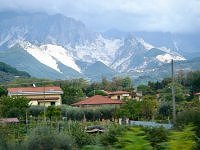
The Carrara quarries were the favored
marble suppliers to Michelangelo.
|
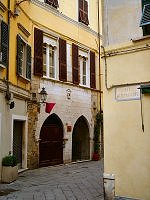
The Buonaparte residence in Sarzana.
|
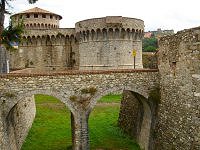
Sarzana's citadel with the Fortress
of Sarzanello on the hill in the background.
|
|
|
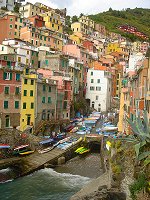
Riomaggiore.
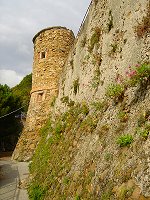
The castello above Riomaggiore.
|
When approaching
it from the south, the Cinque Terre officially begins
at Riomaggiore, a quaint fishing village that spills
down the slope of a hill to the Mediterranean. The
main street now covers the course of the Major River,
the town’s namesake. As one of the larger Cinque Terre
towns and being the southernmost, Riomaggiore is seething
with tourists - Germans, Australians, and especially
Americans. The disproportionate number of our fellow
countrymen is likely attributed to the "Rick
Steves effect" in that the area was prominently
featured on his PBS travel show. What is clear is
that trainloads of tourists arrive every 20 min or
so clad in fleeces, cargo pants, hiking boots, backpacks
and wielding walking poles - resembling an Eddie Bauer
& LL Bean fashion show. Nevertheless, Riomaggiore,
and the whole Cinque Terre for that matter, seems
to subsist on tourists. Each new train brings another
load looking for rooms, food, and charm.
We managed to find
an apartment near the water, and after cleaning ourselves
up a bit, began a tour of Riomaggiore. The only place to
go from the water is up. The main street winds up through
the terraced valley and leads to stairs in all directions
meandering past houses and ultimately to panoramic views.
After a few hours, our legs were burning, so we settled
into an open-air café perched on the side of a cliff
near the train station of all places. The view was spectacular.
A few glasses of wine, and it was back to town for a meal
of pesto, a Ligurian specialty, and mussels.
|
|
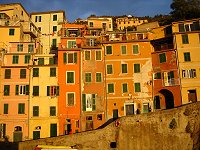
Riomaggiore lights up at sunset.
|

The best place in town for a drink.
|
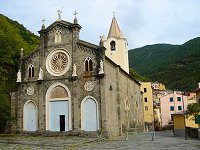
The 14th century church of San Giovanni
Battista.
|
|
|
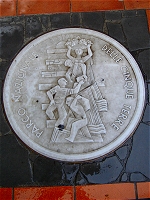
Compliments of the Franklin Mint.
|
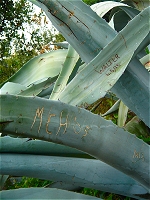
You're the man, Walter.
|
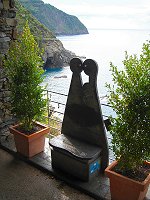
On the Via dell'Amore.
|
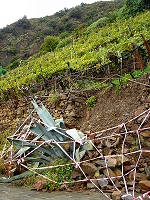
Landslides pose a constant danger.
|
|
|
The next morning
brought more rain, so we whiled away the hours sipping cappuccinos
and chocolate croissants. Riomaggiore is best known for
the Via dell’Amore (Lover’s Walk) path to Manarola that
is carved into the cliff-side. Once the rain let up about
mid-morning, swarms of tourists started heading to Manarola
via this path. The route is indeed breathtaking with benches
carved into the rock at various points and named after characters
in the Odyssey. Sadly, the ambience is ruined by not only
the incessant flow of tourists, but by the pervasive graffiti
that defaces the cliffs, benches, and flora. How desperate
for attention does one have to be to carve their name into
a cactus?
The walk only takes
twenty minutes before you come to Manarola, which look very
similar to Riomaggiore but with fewer restaurants and shops.
We spent an hour or two walking around town and gorging
ourselves on focaccia bread with cheese, rosemary, olives,
mushrooms, and prosciutto. Our goal was to make it to the
third Cinque Terre town of Corniglia, but we learned that
the main path was closed due to a landslide – a common occurrence
in this cliff-dominated region. Thus, the only route available
to us was up and over the ridge that led to Corniglia. To
make matters worse, the sun finally emerged for the first
time just as we began our ascent, with full packs, of the
thousand steps that wound through the olive groves to Volastra,
our half-way point. It didn’t take long before we were regretting
the focaccia bread. It could have easily been nicknamed
the Stairway to Heaven – not because of the beautiful panoramic
views, but because when we got to Volastra, the stores were
all closed. We circled in vain around the village looking
for the commestibli that a sign along the route promised.
Just when we had given up and tried to find the trail to
Corniligia, we happened across an official Cinque Terre
Trail refuge with life-saving Birra Moretti on tap.
|
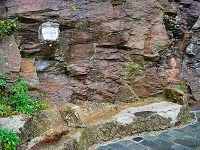
One of the Homeric benches.
 A glimpse of Manarola on the
climb to Volastra.
A glimpse of Manarola on the
climb to Volastra.
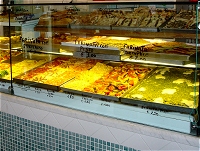
Focaccia selections.
|
|
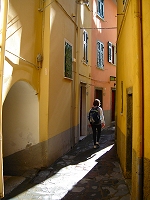
Searching for commestibili.
| 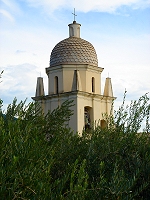
Volastra comes from Vicus Oleastra
(village of olives).
|
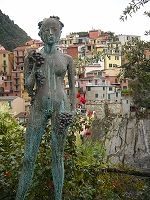
A tribute to the wine harvest.
|
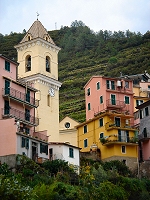
The terraces around Manarola.
|
|
|
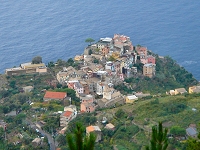
The hilltop town of Corniglia.
| 
A room with a view and the offending
homemade wine.
|
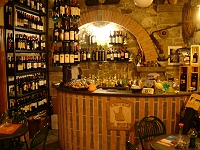
A fine example of an enoteca.
|
|
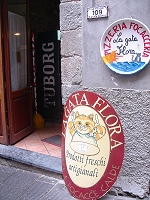
Corniglia is famous for its cats
- and its focaccia.
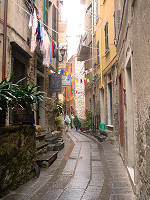
Downtown Corniglia. |
Finding our legs
once again, we descended from Volastra through the olive
groves which soon turned to vineyards. Ambling down a combination
of muddy paths and stairs, we finally caught our first glimpse
of the day’s destination. Corniglia seems to be the forgotten
town of the Cinque Terre. As the middle village of the five,
it doesn’t see the same number of visitors as those at the
ends of the trail. It’s also situated on a promontory some
300ft above the sea and has little to speak of in terms
of a beach. Consequently, hotel rooms are scarce so we knew
that we would have to find a camera somewhere and
soon.
Strolling down
the main thoroughfare with our backpacks in tow, we
were approached by an elderly woman who appeared from
behind a large green door. She inquired as to whether
we needed a room and, after some clumsy negotiation
in Italian, the deal was done. D poked his head through
the green door ready to drop off the pack at the room
but saw only a large concrete floored room filled
with barrels and bottles. Corniglia’s main business
is wine and has been for some two thousand years.
Our new friend smiled proudly as she flung open the
door to invite us into her enoteca that had
a smell so pungent it nearly floored us. We were given
the brief tour before she presented us with a bottle
of her best vintage. After an awkward moment of silence
passed, we quickly realized it was not a gift after
all and graciously offered to pay. Later we sat in
our quaint little room overlooking the vineyards and
toasted another successful day with our homemade vino
rosso – it was utterly undrinkable.
|
|
|
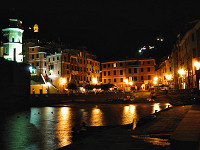
Vernazza harbor after dark.
|
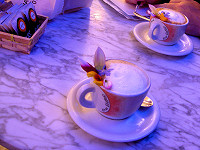
Morning cappuccini.
|
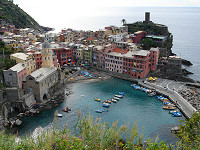
Vernazza from on high.
|
|
|
It was a short
walk to Vernazza the next morning but the initial
view of this port city is spectacular. Vernazza is
by far the most picturesque of the Cinque Terre villages
with Genoan turrets rising above an azure lagoon.
Colorful fishing boats line the town square and beach
in the afternoon, and the pastel facades of the buildings
brighten up the streets even on a dreary day like
the one we had. As usual, our first order of business
was to find a place to sleep for the night. After
some doing, we found a wonderful room with a terrace
overlooking the port. We unwound on the terrace with
a bottle of local wine before venturing into town
to wander the streets. Spoiled by the scarcity of
tourists in Corniglia, we were right back in the thick
of things. The streets and stores were packed with
day hikers and those who were there for the long term.
As the only
one of the Cinque Terre towns with a harbor, Vernazza
has always been the richest of the community along
this stretch. This fact is manifested by the majestic
church Santa Margherita di Antiochia along the main
piazzetta and the 16th century fortifications
built to protect the town from Saracen pirates. We
completed our brief sightseeing circuit and eventually
ended up harbor-side watching the sunset over drinks
and olives. A dinner of fresh pasta came early at
a nearby trattoria. We elected to turn in early
and rest from our grueling day of drinking wine and
lounging. In truth, we were dreading the multitude
of steps involved in the next day's march and wanted
to make sure we were plenty rested.
|

Busted.
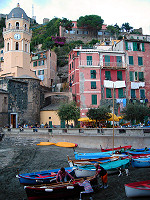
Putting out to sea.
|
|
|
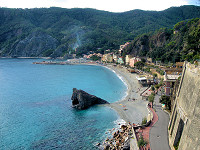
The modern side of Monterosso.
|
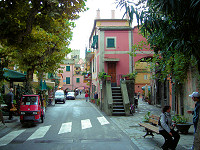
The streets of Monterosso.
|
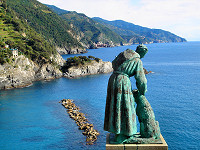
St. Francis and the wolf.
|
|
|
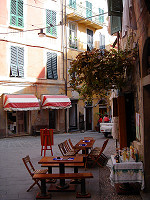
Getting ready for lunch.
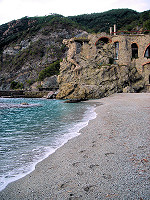
Neptune yearns for the sea.
|
Our worst fears
were realized the following morning as we made our
way out of Vernazza to the final Cinque Terre town.
The path was narrow and muddy as it wound around the
hillsides. We started out early to avoid traffic but
apparently it was not an original idea. Shortly before
noon, we began to encounter other day hikers coming
the opposite way – first a trickle and then a stream.
To compound matters, the trail became more narrow
and slippery until we were forced to step aside and
let others pass. Our progressed was slowed, but we
pressed on when, near Monterosso, the trail began
to descend sharply. Sure footing became more difficult,
but D managed to lumber down the trail with the pack.
On the other hand, J slipped while allowing a group
of hikers to pass and landed square on her backside
in front of them. J was struggling like a turtle on
its back, so D pulled her to her feet. Only her pride
was damaged as J dusted off her derriere and trudged
ahead. The trail soon turned to steps – lots of steps
– hundreds of steps. Our knees aching, we finally
caught a glimpse of Monterosso al Mare.
Monterosso has the
appearance of a large town because it is dissected by a
promontory into an old village and a newer town dominated
by beach and hotels. In reality, it has fewer residents
than Riomaggiore. Nevertheless, it serves as the launching
point for many tourists making incursions into the Cinque
Terre region. Hotel rooms and restaurants are plentiful
but at the expense of the charm and quaintness of the other
villages. |
|
|
|
We had a day to kill before we needed
to make our way back home. Since Monterosso had little to
offer, we thought we would take a short boat ride to Portovenere.
The ride would also give us a chance to recap our hike from
the vantage point of the sea. We were both saddened by the
fact that the distance covered by our grand trek of nearly
four days took only 30 minutes by boat. Eventually, we chugged
into the Gulf of Poets, named for the frequent literary
visitors such as Lord Byron, and marveled at the striped
marble church of San Pietro, patron saint of fishermen,
which dominates the view. This same promontory was the site
of an ancient temple dedicated to Venus, the namesake of
Portovenere. Once docked, we spent a few hours roaming the
backstreets of the port. We passed on the ascent to Andrea
Doria castle perched atop the port having already climbed
our share of hills this week. Instead, we did a little shopping
and indulged in a gelato (or three).
|
|
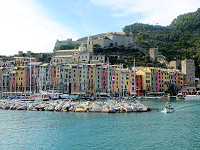
Portovenere.
|

Bronze figurines on the door to San
Pietro.
|
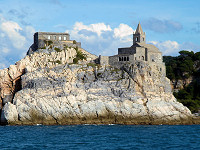
Church of San Pietro.
|
|
|
|
With one full
day left before we had to catch a train back to France,
we decided to visit the famous seaside town of Portofino.
Logistically, however, it didn’t make sense for us
to spend the night there and then backtrack the next
morning. So we opted to pamper ourselves with a luxury
hotel in Camogli instead. After a week of hiking and
small rooms, it was nice to spread out in a comfortable
room with a view of the Golfo di Paradiso. We rested
up and jumped a train to Santa Margherita where we
could find a bus to take us to the bottom of the Portofino
Peninsula. |
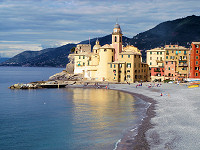
Camogli.
|
|
|

Portofino.
|
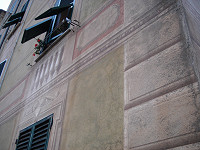
Things are not as they appear.
|

Chiesa di San Giorgio.
|
|
|
The view of
Portofino is surely one of the most photographed sites
in Liguria. You can’t pass a postcard rack without
seeing it. That said, it is indeed a truly stunning
sight to see in person. In fact, legend has it that
the German officer directed to destroy the town and
its munitions depot couldn't bring himsself to do
it and disobeyed the order. In keeping with our trip
thus far, we got a chance to see the picturesque piazzetta
and colorful harbor in a torrential downpour. Portofino
has long been a favorite British tourist spot and
a number of dignitaries and celebrities have built
villas there. Richard Burton even proposed to Elizabeth
Taylor there during one of their go-arounds.
Today this
fishing village is full of high-end boutiques and
art galleries. We spent much of our time waiting out
the storm, but eventually we had an opportunity to
look around. The shops didn’t have much to offer us,
so we wound our way toward the headpoint and a glimpse
of the lighthouse. Along the way, we peeked into the
Chiesa di San Giorgio, a yellow-faced church dedicated
to Portofino’s patron saint St. George. This could
go a long way to explaining the appeal of the town
to the British. As the sun began to set, we made our
way back to Camogli to prepare for our early departure.
Having successfully slipped into Italy with no passport,
D now had to figure out how to sneak back into France
without causing an international incident.
|
|
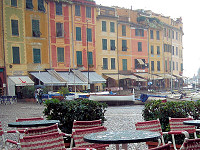
A Ligurian deluge.
|
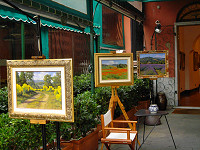
Boutiques and galleries abound.
|

The classic view of Portofino.
|
|
|
|
Copyright © 2005 JnDsTravelog.com. All rights reserved. |
|
|